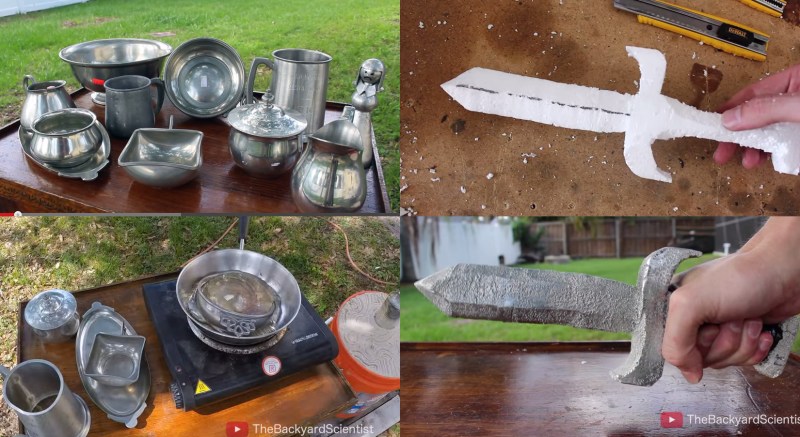[TheBackyardScientist] has been living up to his name, this time by casting a pewter sword in his yard. Pewter is a soft alloy of mostly (85–99%) tin along with copper, antimony and bismuth. Older pewter castings often used lead as well. The great thing about pewter is its low melting point of 170–230 °C. At such low temperatures, pewter can be melted down on a common hot plate. Think of it as an easy way to get into the world of metal casting – no forge required. Of course, anyone who has been splashed with solder will tell you that hot molten metal always deserves a lot of respect.
[BackyardScientist] obtained his metal by hunting the local thrift stores. He used the “lost foam” method of casting, by carving a sword out of styrofoam. The sword was embedded in a 5 gallon bucket of sand with a riser to allow the mold to be filled. The pewter was melted on a cheap hot plate, and poured into the mold. The hot metal melts the foam on contact, simultaneously filling up the cavity left over in the sand mold. [BackyardScientist] was left with a solid pewter sword. It won’t hold an edge, but it is a great illustration of the technique.
Click past the break to see [TheBackyardScientist’s] video.
















Ahhh. no forge required <—- sorry a forge is used to heat metal for working on an anvil like horseshoes or swords.
what you meant to say was a foundry. which is used with a crucible to melt metals for casting.
It never fails to make me laugh at some of the things posted here
Weird, I personally would have said “no furnace required”, my interpretation of foundry would include casting the metal into the mould.
Ignorance and vocabulary fascism do not go well together. Forge comes from old French, meaning to fabricate, and has even earlier roots in the Latin word for workshop. Forge is a perfectly fine word to use and we all know what they are talking about.
I’d like to see an open-source hardware forge. The designs could be published on Sourceforge.
And a open source quenching pail, you could post that on bit-bucket.
The finished product is ugly, but this post did the intended job of getting me to actually research “pewter casting” and now I want to hit the thrift stores. Hide yo kids, hide yo candlesticks.
Hide yo wife they forgin er’body out here.
The guys who do toy soldier casting have elevated this stuff to a science – check out their techniques if you want higher quality castings.
Good suggestion thanks, I just watched a few videos on youtube – interesting way to measure the temperature is not too high with a strip of cardboard. Too high and you will damage the rubber/silicone moulds.
https://www.youtube.com/watch?v=s46uFHlWkMs
Well, that’s primarily because of what the cast is made of I think- a proper mold with a proper form would be much cleaner.
On the ugly part: Makes sense that when you use foam and sand you would want to smooth it down after the cast. Makes sense to me that is.. not to him though.
It pays to take classes on pattern making. Lost foam is always pretty crummy quality.
Could this be applied somehow to home PCB fabrication?
That’s actually a dagger, not a sword.
I would rather call it a dagger shaped tin bat than a dagger or sword. Because the person who gets attacked by it will rather die from kinetic impact damage than from any cuts or stabs
It kills via lead poisoning.
Pretty cool. Also, the zen garden made me laugh.